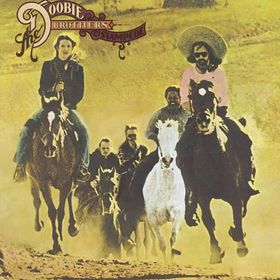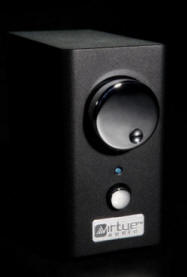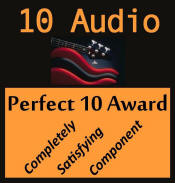The YG Acoustics Kipod Main Modules Speakers have been my reference speakers for over a year and I am just now writing about them. I have enjoyed music through the Kipod (pronounced KEY-pode) with a half dozen different amplifiers, both tube and solid state, and a similar number of preamplifiers, again both tube and solid state. I feel that any review that does not specify the faults of the component is little more than an advertisement. This is the reason I have delayed writing about these very satisfying speakers. For more than a year, over many hundreds of listening hours, I have found no fault. None. But they do have a character. First some obvious strengths, which have been completely consistent with all associated electronics.
The Kipods offer an absolutely consistent tonal or harmonic quality from mid bass, about 60 Hz, to the uppermost limits of the recorded treble. There is no change of character, no wavering or inconsistencies of the sound stage, and no forwardness or recess in any narrow or wide frequency band. With lesser speakers, I often hear a drum set further back in the sound stage than the cymbals, which often seem to be positioned closer to the speakers. Listening to the Kipods, those cymbals are locked in the location of the drums and never wander forward. Likewise, the character of a singer’s voice does not change when she scales from contralto to soprano.

The Kipods are the highest resolution speakers I have heard in my room, including a couple of models with ribbon tweeters. This resolution is consistent across the entire frequency range. There is a confidence that nothing is missing, and every detail, however small, is heard. The tweeter, modified in-house, surpasses other speakers that use a ribbon super tweeter by not needing that extra crossover. As the frequency increases, the density of information increases which can increase the audibility of crossovers. No additional crossover means there are no anomalies in the upper frequencies. All voices and instruments have a wonderful purity of tone in their upper harmonics.
There is a crossover between the 5” woofer and the tweeter. I am usually pretty good at hearing crossover-related artifacts including phase shift, discontinuities in frequency response – both holes and overlaps, inferior capacitors, and minute loudness differences through the crossover region, but I can’t hear this crossover. Believe me, I have tried. The YG Acoustics crossover technology, where both the phase and amplitude are optimized, is – audibly – perfect. Yoav Geva (Gonczarowski), the driving force behind YG Acoustics, does not just measure; he listens for correct sound. If he hears an anomaly that cannot be explained by measurements, then he develops a measurement or method of quantifying the anomaly. This is the ideal marriage of art and science.
The specs are state-of-the-art: within 5 degrees of perfect phase and +/- 1 dB max deviation from perfectly flat frequency response, with usable (room dependent) output from 20 Hz to over 40 kHz. I think the low end (-10 dB) is in the mid-40s. The sensitivity is average for a sealed box 2-way speaker at 86 dB. The overall size is a room friendly 16”H x 7”W x 13”D and the list price of these objects d’art is $17,000. These are precision products for which the image to the right does no favors. The aluminum cabinets are virtually identical with a tolerance of 20 microns, according to the YG Acoustics Web site (link below). Each crossover is individually designed for each speaker. I filled the 23.5” tall $1,500 stands with playground sand and then installed the speakers on the stands, using all 8 machine bolts provided for each speaker. The weight with sand-filled stands is about 75 pounds per speaker. This is one solid assembly! The speakers will never topple off the stands, and I can move them without having to ask a friend for help.
My room is small-medium size, about 1500 cubic feet. The Kipod Main Modules are used with pairs of subwoofers, and I always run the “satellites” full range without a high pass crossover limiting the bass signal to the Kipods. I hope to try the matching Kipod Bass Modules (powered or passive at $21,000) someday, but the after-market subs have included pairs of the JL Audio fathom f112, Velodyne Optimum-12, and Gallo TR-3. There is never a problem with the speakers not being able to play as loudly as I want and they are quite comfortable pressurizing the listening room in to the mid-90 dB SPL (c-weighted) range with peaks around 100 dB which I consider loud. I rarely listen louder. This is outstanding performance from a 5” mid-woofer driver. I have not heard any compression or distortion when the Kipods are playing very loudly in my room.
The sound stage, that illusion of a discernable and realistic performance space, is as solid, stable, deep, wide, tall and huge as from any speaker made today. It suffers very little from moving left or right to where a friend might sit to enjoy the show with you. The sonic image regularly extends about two feet to the left of the left speaker and a similar distance to the right of the right speaker. The image height is consistent from left to right, and the Kipods do not exhibit the common fault of presenting the image as an oval: tall in the center and narrower at the speaker positions. In fact, sound almost never seems to actually come from the speakers as they disappear into the soundscape so completely.
We need to spend a minute or two talking about dynamic range, which is the difference between very, very soft and very, very loud. The ability of a component, including a loudspeaker, to reproduce this entire range is called macro-dynamics. There are smaller changes in loudness, such as we hear in soft or quiet music, and this is micro-dynamics. Almost every component on the market today has the ability to play from very, very soft to very, very loud, within their power and design constraints. But there is a huge difference, deeper than the Grand Canyon, of how well components are able to handle instantaneous changes in loudness. The strike of a drum stick, the tap on a cymbal, the impact of a bass drum as the sound punches your chest, or the crisp bleat of a saxophone are all examples of life-like dynamics. Reproducing this initial impulse, or leading edge correctly is essential for any sound to be perceived as life-like.
In live music, we take this for granted. I suggest that this is one of the most important differentiators of live versus reproduced music. It is certainly a function of having enough power available, and the amplifier must be able to deliver it to the speaker at the correct speed and tonal character as required. Many amplifiers, even though they have the power, do not have the necessary speed or “rise-time” to get that leading edge right – regardless of what their specs might imply. Unfortunately, many of us would not realize this fact about amplifiers because even more loudspeakers are deficient in their dynamic ability and cannot track the rapidly changing music signal. “All in due time” is a nice way of describing most speakers’ dynamic performance. We literally don’t have time for lackadaisical speakers. Speakers must be Ferraris and Porsches, not Buicks and Beetles! Imagine driving on a twisting mountain road that has a speed limit of 35 MPH, but you’re going 100. If you were driving a Buick or Beetle, this would be called “suicide”. However, if you were driving a Ferrari or Porsche, this would be called “a Sunday drive”. The point of this discussion is that the Kipods are agile and precise, and fully capable of doing 100 MPH in a 35 zone. There is no ambiguity at the start of notes, which are often startling in both their realism and clarity. Nor is there is any hangover at the end of notes. The ending harmonic trails last longer than with almost any other speaker, with full resolution and consistent character as the sound fades into a deep, black silence. The explosive dynamic performance of the Kipods mimics live music.
I mentioned above that the Kipod Main Modules have a character. I cannot easily attribute any audio reviewer term to the speakers themselves, but having recently listened to a large number of speakers at last month’s Rocky Mountain Audio Fest 2010, I can offer these observations. The speakers are extremely nimble and “accurate” without sounding lean or threadbare. Remember the computer acronym WYSIWYG? It stands for What You See Is What You Get. It means that what you see on the computer screen is what your printed page will look like. (This was not always the case in the bygone early days of personal computers, which was way back, 15 years ago or so.) For the Kipods, we could apply W I R I W Y G: What Is Recorded Is What You Get. Fidelity to the recording or source material, without change, is provided by the laboratory-grade* Kipods. Their defining character is neutrality, consistency, and transparency, all in the best and most musically consonant meanings of those terms.
* “Laboratory-grade” means that the component is true to the source. This is a step above “reference-grade”, which is simply the current state-of-the-art.
The sound is lush and rich, but without any sense of slowness, syrupy warmth, thickness, or any other word we use to describe an obviously romantic, sweet, or other glowing, golden-hued propensity. The Kipods simply are and they do what speakers are supposed to do, just as a preamplifier that is a perfect “straight wire with gain” does its job perfectly.

Female vocalists are particularly beguiling. Like the Koetsu Urushi phono cartridge, the Kipods can make you lose yourself in the performance. Nicolette Larson’s “Rio de Janeiro Blue” from the In The Nick Of Time LP swept me away. The sound of the trumpet was so real that my head snapped up to stare directly at the musician. The octave-to-octave consistency is highlighted in the Doobie Brothers “Slat-Key Soquel Rag” on Stampede, Warner LP BS2835. Go ahead: turn it up!
But you don’t have to. Listening at lower volume levels is also satisfying because even at reduced levels, the Kipods deliver the complete sonic picture. I find that the music is very enjoyable at significantly lower levels than with other speakers. I just do not feel the need to “crank it” to potentially harmful levels to become immersed in the sound field. We need some level of loudness to pressurize the room, but with the Kipods, this level can be much more neighbor-friendly than you might think. You could enjoy listening far into the night, when your significant other and smaller humans might prefer a quieter environment.
Some listeners will not appreciate the lack of voicing of the Kipods, or of other models in the YG Acoustics product line. If you are looking for a more obvious treble, check out the new Wilson Sasha. If you prefer a warmer, more vacuum tube-type of sound, then a Magico model might worth an audition. However, when you are confident enough in the rightness of real sound – leave the seasonings in the kitchen – and the rest of your system is neutral enough, you might start your search for the ideal speaker with the Kipods and then be done with shopping.
Last February, I attended a group listening comparison at the YG Acoustics factory. The speakers were the new YG Acoustics Carmel and a 50% more expensive Magico model. The nearly full range, floor standing Carmel sounded very much like the Kipods. For the 16 attendees, the final score was 15 preferring the Carmel and 1 tied with the other speaker. Similar results have been reported at subsequent public comparisons.

Now that we have laboratory-grade, highly accurate, extremely resolving loudspeakers, one could easily assume that they require frighteningly expensive and particular electronics to make them sing. They certainly reward quality, but are not choosey. Musical results were obtained with Bryston 3B SST2 ($3850) and Manley Snapper ($4250) amplifiers. An NAD 320 integrated amplifier was surprisingly satisfying and let me hear why this model is held in such high regard without putting a spotlight on its modest roots. An almost pocket-sized Virtue Audio Two.2 integrated amplifier ($588 with upgraded power supply) also made nice music. However, you can mostly forget “mix and match”: using the strengths of other components to balance out or minimize any weaknesses in the speakers, because there really are not any. Electronics with problems in tonal balance or resolution, or the presence of grain or harshness, will be quickly exposed as deficient as clearly demonstrated in my recent review of three preamplifiers.
The Kipods seem to bring out the best in other components, and while they do not highlight weaknesses, they certainly let the electronics’ better qualities shine through. As I type this, an Aesthetix Calypso Signature preamplifier is feeding a pair of Bryston 7B SST2 amplifiers in the adjacent listening room. (I will take a break soon and swap in an Aesthetix Atlas amplifier for this evening’s listening. Friends, we have a wonderful hobby!) I have been forced to stop typing several times today as I was drawn into the listening room to hear a great sounding cut. It really does not get much better. This is the LIAR (listening in another room) test, which the Kipods pass with an A+.
I had a mental blueprint of this review before I started typing. It would be very brief: a short introduction, a few bullets including “perfect” and “no faults” and “own ‘em, love ‘em”, and a close. As the first paragraph flowed from mind to keyboard, I relived some of the great musical moments and feelings I have enjoyed with my Kipods over the last year and simply wanted to tell you how truly and completely enjoyable these speakers are. What was planned to be the shortest of my reviews – very concise – has become one of my longest. Just as it is hard to stop listening to them, it is hard to stop sharing with you how great they are at recreating music in my listening room.
YG Acoustics makes an audacious claim in their advertising: The Best Loudspeakers on Earth. I can offer nothing to refute this claim. After hearing them at the 2009 RMAF for about 15 minutes, I arranged with the very personable Dick Diamond of YG Acoustics to take them home at the end of the show. However, this was not a reviewer’s loan. Mr. Diamond had my check. I have never regretted the purchase and listening to the latest-and-greatest loudspeakers at this year’s show only served to validate my purchase decision. I thoroughly enjoy these fine musical instruments every chance I get.
Another one of my favorite songs is playing in the next room. I’ll be right back.
Overall Rating: 10 LPs

Link to Manufacturer’s Web site: YG Acoustics
Manufacturer’s Response:
There are those things in life that just make sense when you hear about them for the first time. When you continue to read, study or practice in earnest the principles involved in your new discovery and it still makes sense, you know you have something really special. This is how we feel about Mr. Seigel’s review of the Kipod Main Module loudspeakers. It just makes sense.
Mr. Seigel’s comments obviously stem from an exhaustive (but apparently very enjoyable) and extremely well organized method of review. He looks under each rock systematically for deviation and discovery. Jerry covers everything with cautious optimism and highlights those areas of greatest import to the enjoyment of music. He looked for faults without incarcerating the subject and sought the realities of life – specifically the realities of live music – before drawing conclusion.
We can’t thank Jerry Seigel enough for his incredible evaluation of our speaker. We can’t wait until he has opportunity to hear the Kipod’s with their matching Studio Sub!
Gratefully,
Dick Diamond
Director of Sales & Marketing
YG Acoustics
